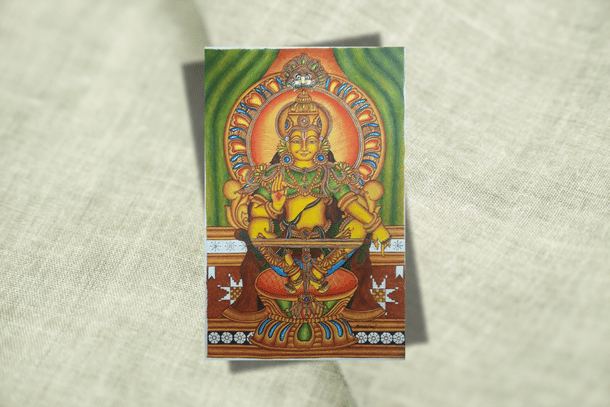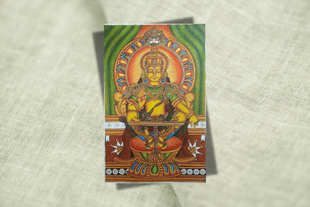Culture
The Most Anthemic Ayyappan Song Ever Is 50 Years Old
K Balakumar
Feb 08, 2025, 06:46 PM | Updated Feb 11, 2025, 02:01 PM IST
Save & read from anywhere!
Bookmark stories for easy access on any device or the Swarajya app.


It is a song whose lyrical authorship is shrouded in some doubt, but there is no question that it is the most popular song in Ayyappan temples wherever they are.
The anthemic Harivarasanam, the sonorous lullaby to which Lord Ayyappa is ritually put to sleep at Sabarimala, is 50 years old.
To be precise, the most famous version of Harivarasanam, sung on the outer praharam, is. As it happens, it is a tune that was first heard in a film.
Yes, the most revered Ayyappan number is cinema's gift to the universe of bhakti.
The Harivarasanam song is over 100 years old. The Sanskrit original is said to have been written in 1921, and it became a de rigueur ditty among the devout in the 1950s after Swami Vimochanananda mainstreamed it among the faithful by singing it at Sabarimala when the doors of the sanctum sanctorum of the presiding deity are ceremoniously shut.
After Swami Vimochanananda, who made the main Ayyappan idol at the temple in Kashi, this rather quaint rhythmic number was carried further by bhajan singers from Kallidaikurichi.
The Harivarasanam song was long thought to be written by Kambankudi Kulathu Iyer, but it later emerged that one Konnakathu Janaki Amma, whose father (Ananthakrishna Iyer) was the Sabarimala Melshanthi in 1921, was the one who penned it. She had not put her name to it, as it was not the done thing when such a musical offering was made to God.
Kambankudi Kulathu Iyer's name became associated with the eight-stanza Harivarasanam as he had formally compiled the song later. The information about Janaki Amma's authorship emerged in the media when her family members claimed they had official records proving the same.
Whoever may have written the lyrics, its first musical form evolved through bhajan singing. In that form, it had a strong and identifiable rhythm pattern, but the actual tune was somewhat undefined.
It Was Religious Work for Merryland Subramaniam
The Sabarimala shrine, which is now visited by committed worshippers from far and wide, was mostly visited by Keralites alone (and some Tamils) in the 1970s.
Trekking to the temple, situated in an arduous hill abode, was back-breakingly tough in those times when facilities for travel and stay were rudimentary.
It was at this time that producer and director P Subramaniam (better known as Merryland Subramaniam), who had made a name for himself through films with stories from Hindu gods and epics, decided to make a movie on Lord Ayyappa.
From the beginning, Subramaniam, who was a devout man, decided not to treat it like every other film. He announced that it would be bankrolled by a trust, and named it Subramaniam Religious Trust. It is not clear whether any other film has been formally produced by a trust.
Subramaniam, who was also the film's director, shot the film at his own Merryland Studios and at Sabarimala. As the temple was getting popular among the Tamils too, Subramaniam came around to the view of making the film in Tamil as well. Rather than dubbing it, Subramaniam chose to shoot it simultaneously in Tamil and Malayalam. Most importantly, he also announced that the entire proceeds from his film would go to Sabarimala temple development.
With such lofty and honorable ideas, the film, with the obvious title Swami Ayyappan, began production at the start of 1975. The film adhered to the usual pattern of religious movies of that time — the screenplay would be a lattice of different stories of devotees and their divine and miraculous experiences. These movies did not hide their sentiments; they were unabashedly religious.
Swami Ayyappan was no different, and it featured a large array of actors and actresses — Gemini Ganeshan, A V M Rajan, K Balaji, V K Ramaswami, Manohar, Master Shekar, and Master Raghu (later known as Karan) were cast in Tamil, while Thikkurissi Sukumaran Nair, P K Abraham, Hari, S P Pillai, Bahadur, Sreevidya, Unni Mary, and Rani Chandra were featured in Malayalam.
A few scenes and actors were common to both versions. Some songs were shared as well, and one of them was the iconic Harivarasanam.
Devarajan's Musical Gift
Subramaniam had no hesitation in choosing Master Devarajan as the music director for both versions, as he had already proved his mettle in religious films that called for rigour in Carnatic classical music.
Devarajan, fully trained in Carnatic music under his father's tutelage, was proficient in fusing Carnatic ragas with film tunes. In that sense, he was much like G Ramanathan in Tamil and K V Mahadevan in Tamil and Telugu.
Devarajan, who had begun his film musical career in the mid-1950s, had struck a wonderful partnership with the then legend-in-the-making K J Yesudas and lyricist Vayalar Ramavarma. The trio's combination is etched in the annals of Malayalam film music forever.
The Malayalam songs of Swami Ayyappan were shared by Vayalar Ramavarma and Sreekumaran Thampi, who also contributed the dialogues for the film. In Tamil, lyrics were handled by the great Kannadasan.
During the discussion stage itself, Devarajan was clear about using the original lyrical ballad Harivarasanam. The question was in what form. There was a suggestion to retain its popular bhajan lilt without much change. But Devarajan understood that for the song to work in religious contexts, its classical structure had to be well defined (as opposed to being just a robust bhajan number whose strength lay in energetic singing). Yet Devarajan did not want to tamper with the song's musical heart.
It was here that his essential musical acumen came into play. He chose a raga that was very close to the one being sung at various Ayyappan bhajan sessions. He opted for the soft strains of Madhyamavathi raga, knowing full well that it was the one meant to signify the formal closure of most singing sessions (mangalam). While he picked Madhyamavathi, Devarajan adroitly decided to stick to the original rhythm pattern.
Yesudas' Brilliance
So what emerged was a new Harivarasanam that in no way diluted the sanctified spirit of the original. Once the musical foundation was formalised, it was left to the peerless Yesudas to provide the melodic muscle.
By the 1970s, Yesudas had become the go-to singer for songs with a Carnatic base. Into Harivarasanam, he poured his innate bhakti that flowed from his truly secular heart, and what emerged was a song for, literally, the god. It was all soul and sensibility.
The film was not just notable for this song; it was a veritable musical tour de force with many other brilliant numbers. The song Sabarimalayil Thanka Sooryodayam, set to the blissful Anandbhiravi raga, is another hall of fame worthy piece.
Yesudas enhanced his reputation with another rendition that stood out for its sincerity and serenity. In Tamil, it became Sabarimalayil Vanna Chandrodhyam, sung by T M Soundarajan, and was notably picturised on him in the film.
Devarajan used the same tune for most songs in Tamil and Malayalam, except for Harinarayana (in Malayalam). This became an altogether different but more substantial Thiruppar Kadalil Pallikondaye.
This song showcased Kannadasan's redoubtable flair for verses on Lord Vishnu, but the highlight was Yesudas' bravura singing, especially towards the end of this rich ragamalika. In the final portions (in Bhairavi raga), Yesudas hit the high notes with rare verve, and to this day, the song remains a milestone in devotional singing.
Both Harivarasanam and Thiruppar Kadalil were so suffused with pristine devotion that they were accepted in more demanding classical platforms whenever Yesudas chose to perform them. They became favourites among audiences there as well.
The Songs of Swami Ayyappan Opened Up a New Musical Market
The legend of the new Harivarasanam quickly spread, and its fervour became mandatory at all Ayyappan bhajans. To this day, it remains the most sought-after Ayyappan song ever.
Yesudas' popularity grew along with it, and he soon became the definitive voice of Ayyappan devotional albums, which became a well-established sub-genre in itself.
That song, along with other numbers in the film, further enhanced Yesudas' career, and a new world of opportunity opened up for him beyond films and Carnatic classical music: devotional albums.
Until the mid-1970s, religious devotional numbers were mostly in Sanskrit (slokas) or in old verses in formal language (like Kanda Sashti Kavasam). The success of Swami Ayyappan's music opened up the market for songs like Sabarimalayil Thanka Sooryodayam, and Yesudas became the master of the genre. He went on to deliver thousands of such songs in various languages throughout the latter part of the 1970s and 1980s, forming an important part of his illustrious career.
The film Swami Ayyappan was a success in both Tamil and Malayalam, and Subramaniam became in demand for more such movies. In Malayalam, Swami Ayyappan was the most celebrated film at that year's state awards, winning awards for Best Cinematography (Masthan), Best Lyricist (Vayalar Ramavarma), Best Child Actor (Master Karan), and Best Film with Popular Appeal and Aesthetic Value.
The film also helped spread awareness about the temple, and it became an even bigger religious hotspot, reaching the levels of Tirupati. The rush to the Sabarimala temple increased significantly since 1975 when the film first hit theaters. The new version of Harivarasanam became so beloved that it was only a matter of time before the Devaswom Board decided to use it ritually every night.
In recent years, there was a minor controversy when it was discovered that the 1975 film version had some incorrect lyrics, and some lines needed to be modified. These issues were apparently addressed with a new recording, though some were unhappy about tampering with the song (especially when its purported incorrect lyrics were hardly noticed).
Harivarasanam became so integral to the Ayyappan religious ecosystem that other films in later years also chose to feature it in its most beloved version. The Kannada film Manikantana Mahime and the Malayalam movie Shabarimalayil Thankasooryodhayam both found a place for Yesudas' timeless classic. Incidentally, both these films had music by MSV.
In essence, the film version of Harivarasanam has entered the canon of classical kritis. Very few film songs have achieved that honour.
That, indeed, is a divine blessing.




